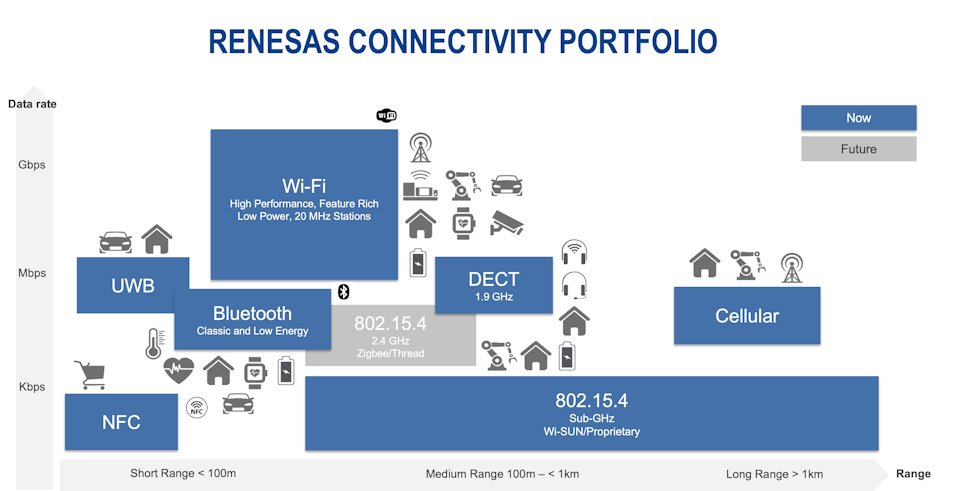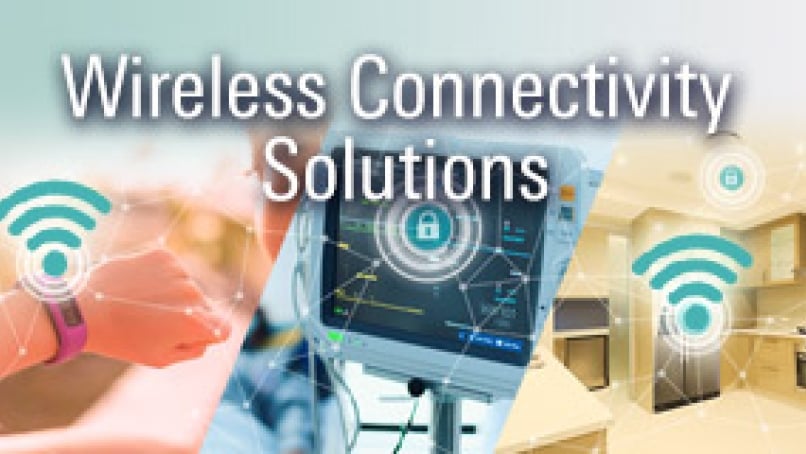Renesas has made its mark in the industry mainly as a leading provider of digital solutions. Over time, we changed that perception through the sustained accrual of deep analog and mixed-signal semiconductor engineering expertise and products. This has enabled Renesas to continue to extend their customer support, portfolio and technologies over the value chain.
The evolution continues today as Renesas continues to invest and delves deeper into wireless connectivity – yet another building block for providing compelling products and customer solutions. In just a few short years, Renesas has built up a diverse wireless portfolio through the acquisitions of Dialog Semiconductor, Celeno, Panthronics, Steradian and a pending offer for cellular chipmaker, Sequans. Renesas’ connectivity solutions now include 4G/5G cellular, along with Wi-Fi 6/6E, near field communication (NFC), Bluetooth and Bluetooth Low Energy (BLE) and Digitally Enhanced Cordless Telecommunications (DECT) for voice and audio.
We sat down recently with Chandana Pairla, who joined the company in April 2023 to unite these individual wireless assets into an integrated connectivity strategy. As the VP of the Renesas Connectivity Solutions Division, Chandana is steeped in wireless technology, having managed Wi-Fi development at Qualcomm and Charter Communications – not to mention a stint at Intel where she worked at the intersection of IoT and AI. We asked Chandana to share Renesas’ emerging connectivity vision.
Renesas: What did you find when you first joined Renesas?
Chandana: I’ve worked in the connectivity space pretty much my entire career, but when I think of Renesas I don’t believe we were necessarily known as a connectivity company. The fact is, we’re not new to the market. We’ve shipped more than 2.5 billion parts and have more than 570 employees working on connectivity solutions in 15 countries. The difference is that, now, we have really compelling, leadership products and solutions with unified teams working on an integrated roadmap and strategy that includes leaning into the world’s strongest portfolio of MCUs to increase our attach rate.
Renesas: What were your first priorities as you began your new role?
Chandana: The first questions I asked myself were, "What is our overarching vision, and what is my purpose here?" I believe these are queries that resonate with every team member, but when I engaged with the team, I found that the responses and perspectives varied widely. This was only natural as the team comprised of individuals working across diverse technologies and cultures that came together to be the Renesas connectivity team, but this to me highlighted the need to align on a singular vision and shared purpose for the organization.
Renesas: Once you recognized that your connectivity assets were scattered across the globe and many different organizations, how did you begin reconciling those assets to unlock their potential?
Chandana: We had been operating in siloes that made it difficult to realize our ambition to scale the business. I applied a people, product and process framework. For people, the goal was to form a singular Renesas connectivity identity by breaking down silos, integrating all of our acquisitions and putting the leadership team in place. In terms of products, we focused on streamlining diverse portfolios to better enable us to pursue a broader market-attach strategy that leverages the strength of Renesas in the MCU and MPU space. From a process standpoint, our focus was achieving predictable execution and standardizing how we work across different teams and geographies. The result is that our team now has a unified vision to fulfill Renesas’ purpose statement “to Make Our Lives Easier” through connectivity solutions focused on three things: innovation, quality and cost competitiveness.
Renesas: How has that been playing out?
Chandana: In the first six months I was here, we spent a lot of time on an employee engagement process that had me visiting several of our sites, meeting the team, and learning about their day-to-day challenges as well as communicating the vision, mission and strategy. Using input from these sessions, we began redesigning our organization, detailing a combined roadmap, and mapping out a timeline to standardize our processes and make changes to tools and software. With this new structure in place, we’re now taking teams that had been spread across different organizations and turning them into horizontal teams tasked with unifying architectures, processes and work models. One major change is that we’re no longer building products in a standalone fashion, we're building families of products that reuse IP across our portfolio. We’re also integrating our connectivity solutions with other Renesas products in what we refer to as Winning Combinations. We have more than 100 Winning Combos in our connectivity portfolio at this time.

Renesas: Can you describe the importance of company culture when it comes to assimilating so many different design teams, of varying sizes and with different work styles and geographic distinctions?
Chandana: Initially, I think some of these organizations were left almost as islands, and they all worked at their own cadence without much integration. I’ve received a lot of positive feedback on our new, collaborative approach, which is having a positive impact on product execution. The engineers are starting to see that they’re able to expand their scope because the range of opportunities before them has increased tremendously. Overall, I'm excited by this transformation and how much energy I see from the team.
Renesas: Turning back to customers, what is the single most common design consideration you and your team are helping customers address regardless of the connectivity modality?
Chandana: If there is one thread across our product portfolio, it's a commitment to low-power architectures. If you think about devices operating at the edge of the IoT, a lot of them can be untethered – they don’t connect to main power and are more likely to run on batteries. In that case, we’re incentivized to have these devices run for as long as they possibly can without needing a battery change/recharge. It’s extremely critical for us to deliver the lowest power and lowest system cost because we are going to be shipping these products in the billions.
Renesas: Finally, what is the single takeaway you’d like customers and colleagues to understand about your priorities?
Chandana: One of the things I learned early on in my career is that to be successful your products need to be first to market. If you can’t be first to market, you have to have the best product, and if you can't be the first or the best, you have to offer the best overall value. We're going to do all three of those things. We see an opportunity for explosive growth from our connectivity portfolio as we leverage our technical and market expertise in conjunction with our massive embedded processing customer base to deliver a friction-free, highly differentiated experience for the customer.
To learn more about Renesas’ wireless connectivity solutions, click here.
A whitepaper titled “Simplifying the Connected Future: Navigating Complexity in the IoT Landscape with Renesas Wireless Connectivity” is also available here.


